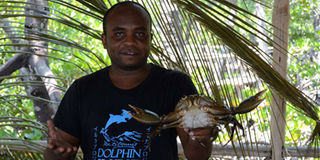Premium
You can earn a living while protecting habitats, fishers told

Dabaso Creek Conservation Group member, Kahindi Charo, holds a mud crab at their Crab Shack Restaurant in Dabaso, Kilifi County. The group fattens crabs in floating cages as a source of income and serve crab meat and samosas at their restaurant which is popular to both local and international tourists. PHOTO | MATHIAS RINGA | NATION MEDIA GROUP
Conservation groups in Kilifi County have launched a campaign to sensitise communities living near marine parks and ocean creeks on preserving fish breeding sites.
The groups raised fears about dwindling fish stocks in the county due to continuing destruction of their natural habitats because of pollution.
They cited the destruction of the mangrove forest along the Kenyan coastline and poor fishing methods as some of the challenges that also affect the marine ecosystem.
Arocha Kenya in Watamu planned a fishing competition to educate local fishermen on proper fishing methods to save sea animals. The organisation is at the forefront in conserving the Mida creek and Arabuko Sokoke forest.
The competition, organised at the Mida creek, aimed to enlighten fishermen that they can earn an income without using harmful fishing methods.
The Mida creek is a tourist site famous for bird watching, boardwalking and canoe rides organised by young people.
Arocha officials Queen Elizabeth cited poor fishing methods and the destruction of the mangroves that threaten different marine species.
She said they work with the Kenya Wildlife Service in schools to also sensitise students on the importance of conserving the marine ecosystem.
“By creating awareness among the community, we let them know the importance of these species," she said.
Apart from community awareness, the organisation aims to nurture the fishing trade.
“We want to use the annual competitions to motivate fishermen on how to earn good money from fishing. Some people have always thought that fishing is not productive and fishermen will always be poorer,” she said.
Mwambao Mangroove Conservancy group chairperson Kassim Shali said most destruction happens at night.
He said it is a challenge for them to protect the mangroves. The trees produce high-quality timber and poles for building homes and other structures.
It is also used to make different types of furniture.
"The Maya and Watamu areas have big, strong mangroves trees, targeted by the invaders, who often cut and transport them at night. This has to stop," Mr Shali said.
Mr Shali said the degradation affects many sea animals, leading them to migrate to other areas for safety.
He said fish will become scarce when their breeding sites are destroyed.
“Mangrove forests are the best breeding sites for fish but if the destruction continues, then soon there will be no fish,” he said.
Mr Caxton Chivatsi, of Careway Trust, a conservation group on the Maya island, said they patrol the forest to protect them.
Mangroves, he said, are breeding sites for prawns but these creatures are disappearing because their habitats have been degraded.
"Prawns breed in these mangroves under the muddy environment and fishermen depend on them for their livelihoods," he said.
He added: “The community should protect the forests and make sure that they are well-protected."





